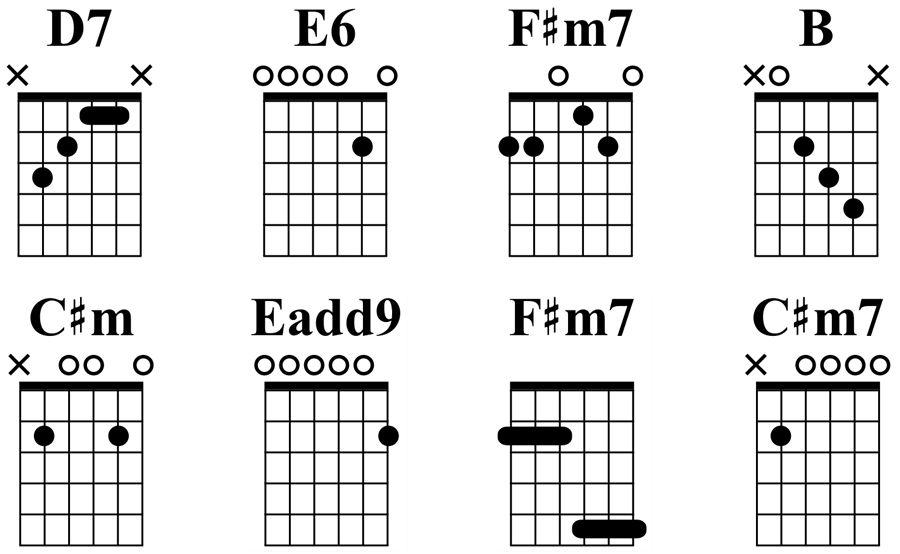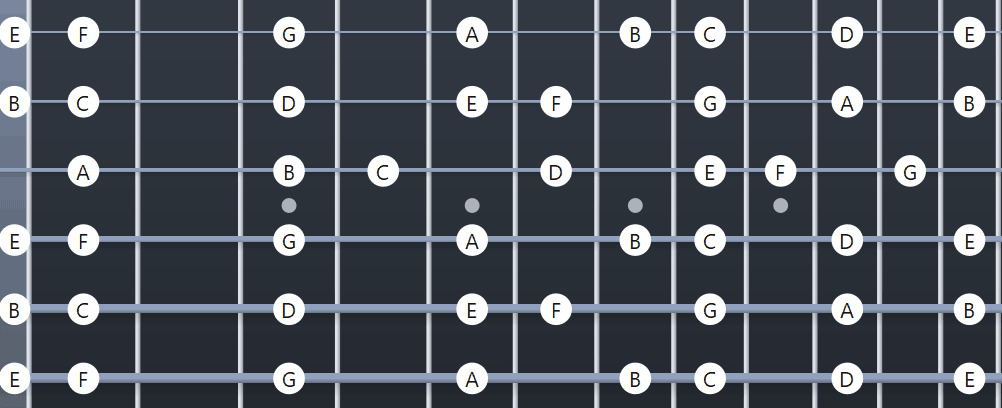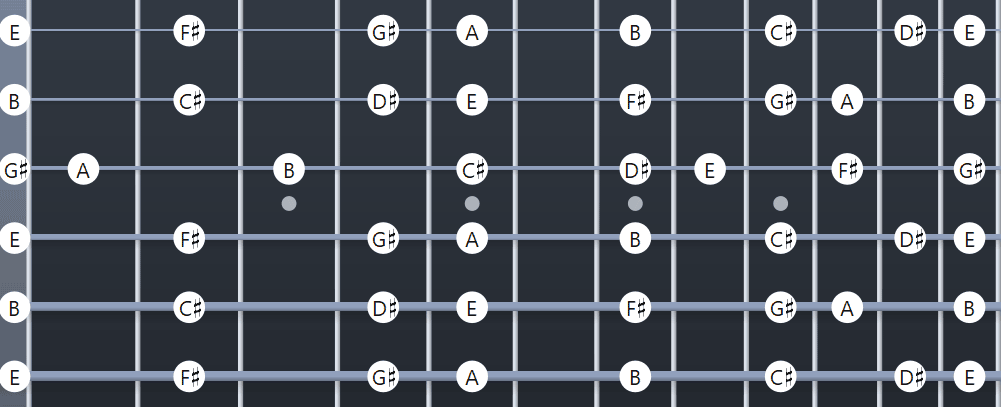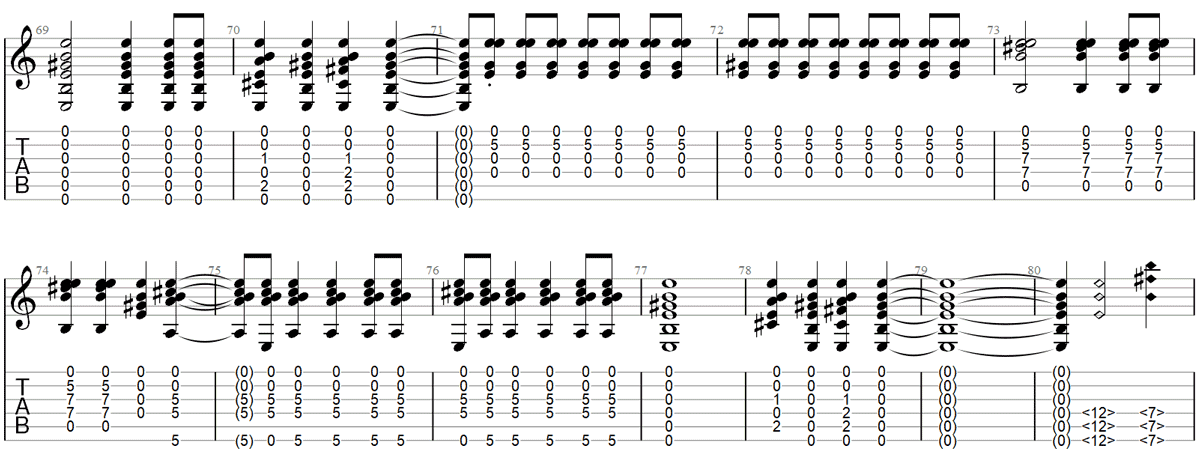Open E Tuning is a fun tuning to use on guitar as you’re able to play full open chords with a single finger or a guitar slide.
In this guide, you will learn:
- How to tune your guitar in Open E
- Easy chord shapes you can play in Open E Tuning
- A printable PDF with chord charts
- Scale diagrams for Open E
- Great songs in Open E tuning with Guitar TAB
Once you read through this guide, check out my Ultimate Guide to Alternate Tunings to learn about other popular open tunings as well as some weird alternate tunings worth trying out.
If you want to try and use a guitar slide in Open E tuning, check out this lesson for some tips on how to get started.
How to Tune Your Guitar in Open E Tuning
To tune your guitar into Open E, you need to change your strings to E B E G# B E.
Keep the Low E, High E, and B strings the same as Standard Tuning. Raise the A string a whole step to B and the D string to E. Raise the G string to G#.
Use a good tuner and once you get through all six strings, go back and check the tuning again. Changing into an alternate tuning like Open E Tuning changes the tension on the neck, so you may need to make a few adjustments in tuning as the guitar neck settles to the new tension.
Keep in mind that some of the strings in this tuning are tuned higher than Standard Tuning. Adjust the tuning on those strings slowly to help prevent breaking any strings.
Raising the tuning on a string increases string tension, which may feel uncomfortable to play. So if you really enjoy playing in this tuning, you might consider changing to a lighter gauge of strings.
Check out this guide to learn more about string tension and gauges.
The higher string tension when you change to Open E Tuning may also increase the action height on your guitar. This might be good or bad, depending on your playing style. If your guitar suddenly feels awkward to play, you may need to adjust the action height. Check out this guide to learn more about action height.
Open E Tuning Chords
What makes open tunings like Open E fun to play is how easy some chord shapes are. You can play full chords with one finger, or you can slide back and forth between chords with a guitar slide.
Major chords in Open E Tuning
Here is how you play Major chords in Open E tuning:

This is why open tunings are so popular with slide players – you’re able to play a full chord across a single fret.
To play an E Major chord, you simply strum the open strings. To play a G Major chord, flatten your finger across the third string.
If you haven’t learned how to play barre chords before this might feel awkward, but once you get the hang of pressing your finger across the strings, you’ll see why open tunings are so popular.
Minor chords in Open E Tuning
While Major chords are simple in Open E, there are still a few easy chord shapes for minor chords.
Here are a few examples of minor chord shapes in Open E tuning:

Some of the above chord shapes are moveable, which means you can shift them up the fretboard to find other minor chords.
I suggest starting by learning the root note positions for each of the moveable chord shapes shown above. For example, the root note position for the Gm chord above is on the low E string. This means you can move this chord shape anywhere you want and the root note for the chord will always be on the sixth string.
Seventh chords in Open E Tuning
To play a seventh chord in Open E tuning, simply start with the Major chord shape and raise the second string by three frets as shown below:

If you remember this pattern, you can easily change any Major chord in a chord progression to a seventh chord as you like.
Sus2 and Sus4 chord shapes in Open E Tuning
Here are two easy moveable chord shapes for suspended chords in Open E tuning:

You can see that we get Gsus4 if we take the Esus4 shape and move it up to the third fret. Practice moving these two shapes up the fretboard to find other sus4 and sus2 positions.
Suspended chords are a great way to add something different to a chord progression, so take some time experimenting with adding one or two of these into a chord progression.
Open chords in Open E Tuning
Here are some other easy chord shapes for Open E Tuning. Try coming up with chord progressions using a combination of the below chords and the chords covered above.

If you repeat the same chord shapes over and over in a progression, it can feel a bit stale. Mixing things up with some of the above chord shapes can be all it takes to turn an okay sounding progression to a great sounding progression.
There are more chord shapes you can use in Open E Tuning, but the above chords give you a good starting point. Some of the above shapes are moveable, so experiment with moving them around the fretboard.
If you take the time to memorize the note positions on the fretboard, you’ll be able to come up with more chord shapes.
Open E Tuning Chords PDF
Here is a printable PDF with all of the above chord shapes in Open E Tuning.
For more downloads and updates, subscribe to email updates here.
Thank you to all my subscribers for supporting Guitar Gear Finder so I can write helpful guides like this one. If you found this guide helpful, please share it on social media to help spread the word.
Open E Tuning Scales
If you enjoy strumming chords in Open E Tuning, learning the note positions on the fretboard will allow you to also start playing licks and riffs.
Read through this lesson for the best methods to memorize the fretboard. While the lesson talks about memorizing the notes with standard tuning, the same methods can be used with open tunings.
Here are the notes of the C Major scale in Open E Tuning:

One of the best things about Open E Tuning is that three of the strings are identical to what they are in Standard Tuning. This means if you have already memorized the fretboard in Standard Tuning, you already know the positions for five out of six strings.
The only string you will need to re-learn is the G# string. Even that is easy to learn as you simply need to shift everything up by one fret in your mind compared to the G string in Standard Tuning.
While the above diagram may look confusing at first, it will quickly become clear how easy Open E Tuning is to memorize.
The above diagram of the C Major scale is a good starting point to get used to the tuning. But a better scale to learn is the E Major scale because that’s what the tuning is based on.
Here is the E Major scale in Open E Tuning:

A lot of songs that use Open E Tuning are in the key of E, so it’s worth spending some time memorizing this scale.
Open E Tuning Songs
There are plenty of great songs in Open E Tuning you might want to learn to get an idea of what open tunings allow you to play.
Tune your guitar to Open E Tuning and try out the below songs. I have a list of more songs after the first couple of examples.
Gimme Shelter by The Rolling Stones
While Keith Richards uses Open G Tuning far more often (learn about Open G Tuning here), Gimme Shelter is a great example of Open E Tuning.
The intro rhythm part as shown in the below Guitar TAB shows how this tuning forces you to rethink simple riffs and chord shapes.

This song is in the key of E (shown by the four sharp signs in the key signature above), so if you want to learn this song, take some time memorizing the E Major scale diagram as shown earlier.
Once you learn the E Major scale, the chords and shapes Keith plays in this song will make far more sense.
The chorus as shown in the below Guitar TAB shows how simple chord shapes can be used in Open E Tuning:

Notice in the fourth bar how Keith rapidly changes between the open strings and the fifth fret chords. This sounds great thanks to the tuning and wouldn’t be possible in Standard Tuning.
If you haven’t learned barre chords yet, this song will give you great practice at flattening your index finger across the strings. You can see that he doesn’t play across all six strings, so these chords are easier to play than typical barre chord shapes.
She Talks to Angels by Black Crowes
This song does a great job at showcasing the unique chord progressions you can come up with in Open E Tuning. Many of the chord shapes used make use of a lot of open strings, so you end up with a very big sound on an acoustic guitar.
The intro plays a simple lick ending the full open E chord:

I suggest jamming around this basic idea to get a feel for the note positions in Open E Tuning. Use the earlier scale diagrams to find the note positions and try to write your own licks and riffs based on the above TAB.
The below chord progression from later in the song shows some unique chord shapes you might want to play around with:

The last bar ends with some harmonics, which sound fantastic in open tunings. You can play full chords using natural harmonics in Open E Tuning.
Here are some songs in Open E Tuning:
- Statesboro Blues by The Allman Brothers Band
- Jumpin Jack Flash by The Rolling Stones
- Midnight in Harlem by Derek Trucks
- Rocky Mountain Way by Joe Walsh
- Headlong Fight by Rush
- It’s So Easy by Guns N’ Roses
- Just Got Paid by Billy Gibbons
- Hurts Like Heaven by Coldplay (live version with capo on 6th fret)
- Over Now by Alice in Chains
Another thing to keep in mind is that a lot of guitarists will tune their guitars to Open D Tuning, then place a capo on the second fret to get Open E tuning.
So if you see any song in Open D Tuning with a capo on the second fret, you can play that song in Open E Tuning instead and it will sound the same.
To learn about other alternate tunings, check out my Ultimate Guide to Alternate Tunings here.
Here are some other open tunings to try out:
- Open C Tuning
- Open G Tuning
- Open D Tuning (very similar to play compared to Open E)
I’ll be creating more useful resources like this guide over time. Subscribe for email updates to be notified of new guides and resources.
